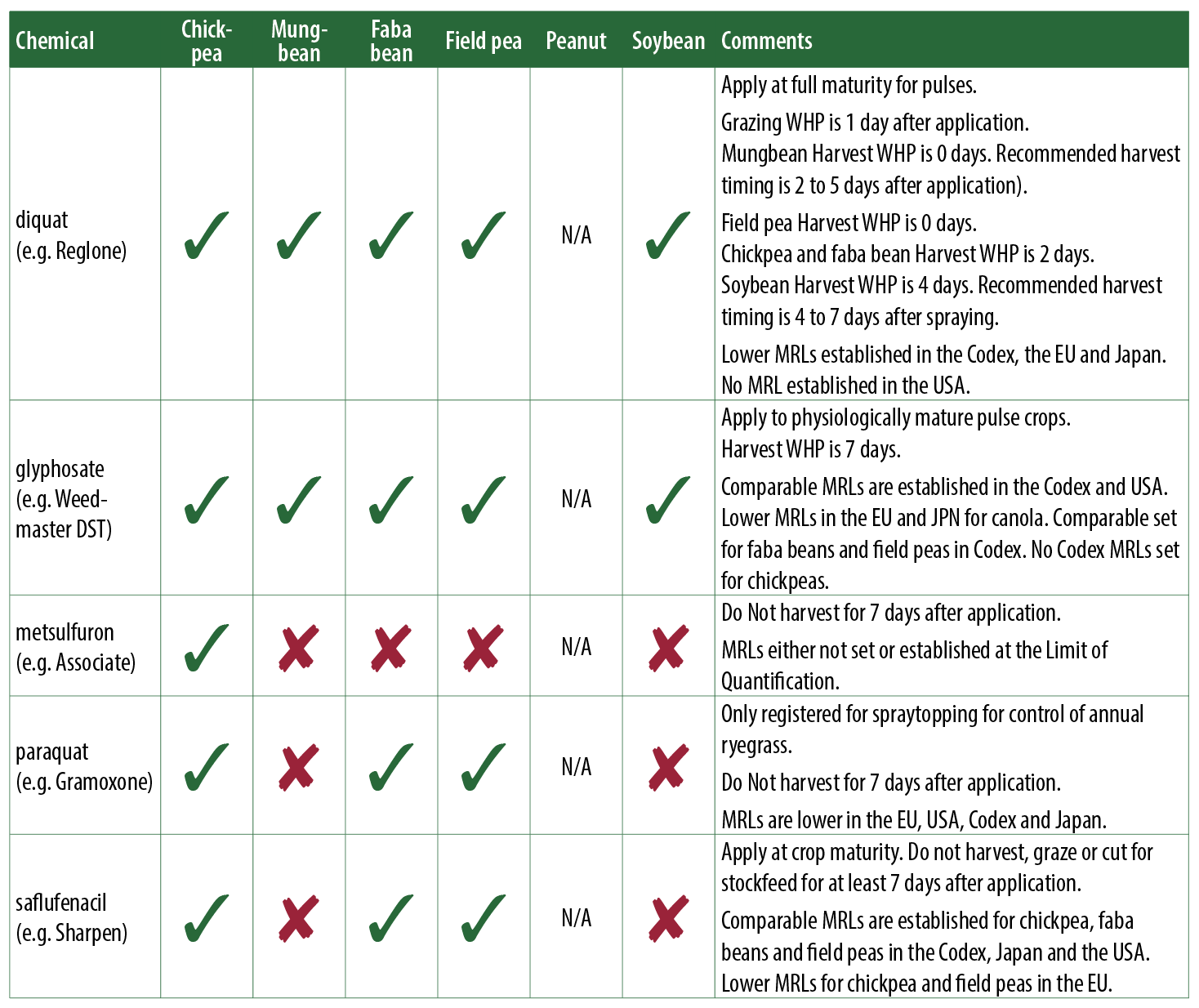Desiccation options for northern pulse crops
- Be aware of market risks involved with herbicide and desiccant use close to harvest this season.
- Pulse growers are advised to be aware of possible marketing restrictions that may arise from using certain herbicide/desiccant products this season.
- The majority of Australia’s pulse production is exported to feed the world. Market access is critical to the Australian pulse industry, and growers play a key role in keeping the doors open.
- Growers are encouraged to review all of the following information before proceeding with their pulse crop management plans.
Important information for growers
What are the herbicide and desiccant products for this season?
For pulse crop production in Australia, the approved late season and pre-harvest products include diquat (e.g. Reglone), glyphosate (e.g. Weedmaster DST), metsulfuron (e.g. Associate), paraquat (e.g. Gramoxone) and saflufenacil (e.g. Sharpen).
What are the risks of using these product?
There is no risk to exceeding the domestic MRL if products are applied in accordance with label instructions, and witholding periods are observed.
What can growers do to mitigate the risk?
Ensure product residues remain at levels well below accepted maximums by following these simple steps:
- Use only permitted products: Using products not approved for specific use is not only against the law, it also places a high risk on maintaining market access for the whole industry when MRLs are exceeded.
- Do not exceed the product’s labelled rate: Regulations for individual chemicals are set to allow growers to properly use the product without fear of violating domestic MRLs. However, these guidelines assume that the labelled rate is not exceeded. If you exceed the labelled rate, you risk surpassing recognised MRLs and this can have serious consequences in terms of both domestic pesticide laws, and international acceptance of the crop.
- Time the application according to the label: Labels are very specific in terms of crop staging. Follow label instructions and apply crop protection products only at the recommended crop stage, so that you do not risk exceeding the maximum residue limits making your crop difficult to market.
- Consult with your exporter/processor about which products are acceptable in international markets: The MRLs in these markets may be different to those set in Australia so your exporter/processor will have a good sense of which markets may be sensitive to specific products. They will likely ask you what was used in your crop and possibly for more information.
Source: Broadleaf crop desiccation and croptopping
Registered products and recommended timing of harvest
This advice applies only to the crops and example products outlined in the table below and was correct on 16 September 2019. Always read the label and follow the directions. Other commercial products may also be available and the label instructions may vary between products.

Harvest timing
Diquat (e.g. Reglone)
- Soybean – spray when 80% of the pods are yellow/brown and the seeds are ripe (yellow and pliable). Desiccation of weeds and foliage aids timely and efficient harvesting, minimises costs and increases yields. Harvest 4 to 7 days after spraying
- Mungbean – apply when 80 or 90% of pods are black or brown. Desiccation of weeds and foliage aids timely and efficient harvesting, reduces harvester wear and tear but can increase harvest losses. Harvest 2 to 5 days after spraying
- Field peas – spray as soon as the crop has reached full maturity. Helps overcome slow and uneven ripening and weed problems at harvest.
- Chickpeas, faba beans – spray as soon as the crop has reached full maturity. Helps overcome slow and uneven ripening and weed problems at harvest. Harvest after the 2 day WHP
Glyphosate (Weedmaster DST)
- Chickpea – apply when physiologically mature and less than 15% green pods. Desiccation can occur when 80-85% of pods have turned from green to yellow-brown and 90% of seed has begun to lighten in colour (indicating physiological maturity)
- Faba beans – apply when pods turn black and average seed moisture content is below 30%
- Field peas – apply when pods turn yellow and average seed moisture content is below 30%
- Mungbeans – apply to mature crops when pods are brown/black
- Soybean – apply only after seed pods have lost all green colour and 80 to 90% of leaves have dropped
- DO NOT HARVEST within 7 days of application. Speed of crop desiccation is dependent on crop stage, growing conditions and weather conditions during and after application
Metsulfuron + glyphosate (Associate + Weedmaster DST)
- Chickpea – apply when physiologically mature and less than 15% green pods. Do not harvest for 7 days after application. Do not graze or cut for stock food for 7 days after harvest. Speed of crop desiccation is dependent on crop stage, growing conditions and weather conditions during and after application
Paraquat (Gramoxone)
- Spraytopping for annual ryegrass control in Chickpea, field pea, faba bean 7 days WHP, grazing WHP also apply check label
Saflufenacil (Sharpen)
- Faba bean – hilum black in the pods at the top of the canopy (30 to 80% of pods ripe and dark)
- Field pea – 30% seed moisture or when lower 75% of pods are brown with firm seeds and leathery pods
- Chickpea – 80 to 85% of pods within crop have turned yellow-brown
More information:
- Assessing soybean maturity
- MRL essentials for pulses
- GRDC Pre-harvest herbicide fact sheet
- Desiccation and croptopping in pulses
Read Pulse Check blog articles | Pulse Check Coastal facebook | Subscribe to the monthly newsletter

